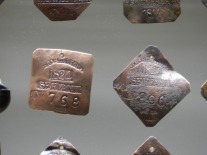
The Charleston Museum, modeled after the British Museum, has something for everyone. This wrought iron gate serves as the inspiration for the museum’s logo.
Like history? Science? Taxidermy? Gems and jewels? Then you’re gonna love the Charleston Museum. Styled after the British Museum, the museum relates the story of us, our earth, our history and who we are yesterday and today. Best of all, everywhere you look is something you probably haven’t seen before — or else it’s something you want to see again.
Here are nine of my favorite things. You can go find your own — come back and let me know what you saw.
1. The piano George Gershwin used to write Porgy and Bess. What a thrill to lay my eyes on the ivories where “Summertime” was born.

Little bits of metal served as licenses that permitted enslaved men and women to hire out their own time. Their earnings were shared with their owners.
2. Slave tags. I can’t even imagine who came up with this idea but there was a time when human beings had to wear these tags when they were looking for work on their own time. The little metal badges were stamped with the type of job the person could do. There were even tags for free men and women.

A grave marker that resembles a bed’s headboard was once a popular way to remember lost loved ones. RIP.
3. Headboard for the dead. Who needs a tombstone when you canget a headboard for your eternal rest?
4. The Swamp Fox’s decanter. General Francis Marion, a South Carolina native, was a hero of the American Revolutionary War, the creator of modern guerrilla warfare, and carried a delicate decanter with him.
5. Flowers from Fort Sumter. These poses were attached to the American flag when it was returned to the fort in April 1865. They were gathered and pressed and now reside at the museum.

Laura Bragg, the museum’s first woman director, created these traveling exhibitions to take museum pieces to area schools.
6. A Bragg Box. These traveling cases took the museum to local schools. They are named for Laura Bragg, Charleston Museum’s first female director (in the 1920s), who developed them. A tribute to museum staff — now that’s something you don’t see everyday.
7. The scariest polar bear I ever saw. Also the only one I’ve ever seen stuffed. Recovered in a frozen section of Alaska in 1961, it has no South Carolina connection. So much for global freezing (whew!).
8. The Rosetta Stone. Well, a copy of the famed stone. The case cam from the British Museum in the 1890s and reflect the museums goals to collect, well, everything.
9. George Washington’s christening cup. The sterling silver cup madden Edinburgh was given to a two-month-old George Washington in honor of his christening in April 1732. It’s engraved with two monograms. GW is the obvious one. The other is JS and the identity of that monogram’s owner remains a mystery. The cup was given to the museum in 1998, its 225th anniversary year.
Ⓒ Text and photos
Mary K. Tilghman






You must be logged in to post a comment.